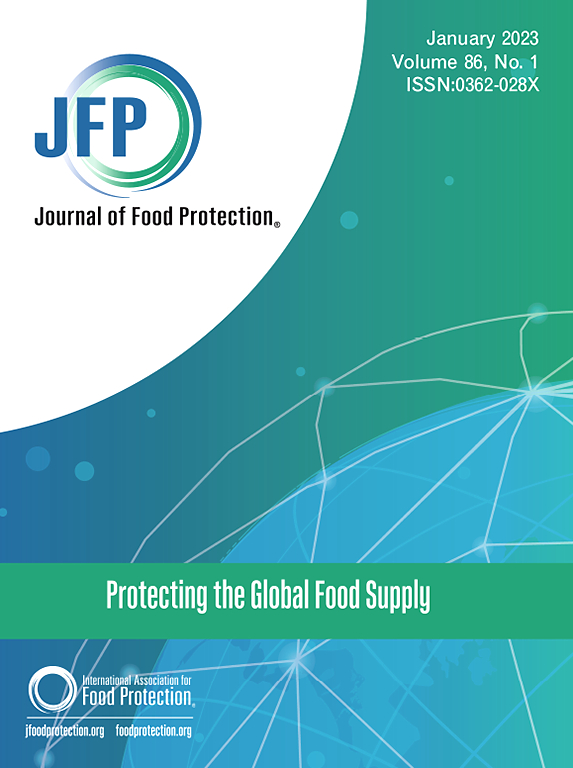The Impact of an Extended Bleed-to-evisceration Interval on the Microbiological Quality of On-farm Slaughtered Cattle Carcasses
IF 2.1
4区 农林科学
Q3 BIOTECHNOLOGY & APPLIED MICROBIOLOGY
引用次数: 0
Abstract
The uncertainties surrounding the microbiological risks of an extended exsanguination-to-evisceration interval have limited the implementation of on-farm slaughter in Europe. On-farm slaughter is increasingly advocated by farmers, consumers, and policymakers as a humane alternative to traditional slaughterhouse operations. However, concerns about hygiene and food safety, particularly bacterial contamination, have led to stringent time limits imposed by Member States on the interval between bleeding and evisceration. Microbiological standards for bovine carcasses in the European Union are governed by Commission Regulation (EC) No 2073/2005, which sets process hygiene criteria for aerobic colony count and Enterobacteriaceae. To investigate whether extending the bleed-to-evisceration interval compromises meat safety, five Holstein dairy cattle were slaughtered on-farm, with samples collected from the internal paralumbar area in contact with the intestines for up to 4 h postmortem. The samples were analyzed for Enterobacteriaceae, aerobic colony count, and Escherichia coli. None of the samples exceeded the established thresholds of 1.5 and 3.5 log CFU/cm2 for aerobic colony count and Enterobacteriaceae, respectively, as defined by Belgian health authorities for the nondestructive sampling method. These preliminary findings suggest that on-farm slaughter with evisceration occurring up to 4 h post-mortem does not pose increased microbiological risks to human health. However, further research is necessary, particularly under warmer environmental conditions and with a larger sample size, to confirm these results and to explore additional factors that may influence bacterial translocation and digestive tract wall integrity.
延长从放血到切割的时间间隔对农场屠宰牛胴体微生物质量的影响。
在欧洲,农场屠宰的实施受到了限制,因为延长动物从放血到开膛剖腹的时间间隔所带来的微生物风险存在不确定性。越来越多的农场主、消费者和政策制定者提倡农场屠宰,认为这是一种替代传统屠宰场操作的人性化方式。然而,对卫生和食品安全的担忧,尤其是细菌污染,导致成员国对放血和开膛之间的时间间隔做出了严格限制。欧盟委员会第 2073/2005 号法规规定了牛屠体的微生物标准,该法规设定了需氧菌落计数和肠杆菌科细菌的加工卫生标准。为了研究延长出血到内脏切除的时间间隔是否会影响肉类安全,五头荷斯坦奶牛在农场被屠宰,并在死后四小时内从与肠道接触的内脐部位采集样本。对样本进行了肠杆菌科、需氧菌落计数和大肠埃希氏菌分析。所有样本的需氧菌落计数和肠杆菌科细菌含量均未超过比利时卫生部门为非破坏性采样方法规定的 1.5 和 3.5 log CFU/cm2 的阈值。这些初步研究结果表明,在农场屠宰并在死后四小时内开膛不会增加微生物对人类健康的危害。不过,有必要开展进一步的研究,尤其是在更温暖的环境条件下和样本量更大的情况下,以证实这些结果,并探索可能影响细菌转移和消化道壁完整性的其他因素。
本文章由计算机程序翻译,如有差异,请以英文原文为准。
求助全文
约1分钟内获得全文
求助全文
来源期刊

Journal of food protection
工程技术-生物工程与应用微生物
CiteScore
4.20
自引率
5.00%
发文量
296
审稿时长
2.5 months
期刊介绍:
The Journal of Food Protection® (JFP) is an international, monthly scientific journal in the English language published by the International Association for Food Protection (IAFP). JFP publishes research and review articles on all aspects of food protection and safety. Major emphases of JFP are placed on studies dealing with:
Tracking, detecting (including traditional, molecular, and real-time), inactivating, and controlling food-related hazards, including microorganisms (including antibiotic resistance), microbial (mycotoxins, seafood toxins) and non-microbial toxins (heavy metals, pesticides, veterinary drug residues, migrants from food packaging, and processing contaminants), allergens and pests (insects, rodents) in human food, pet food and animal feed throughout the food chain;
Microbiological food quality and traditional/novel methods to assay microbiological food quality;
Prevention of food-related hazards and food spoilage through food preservatives and thermal/non-thermal processes, including process validation;
Food fermentations and food-related probiotics;
Safe food handling practices during pre-harvest, harvest, post-harvest, distribution and consumption, including food safety education for retailers, foodservice, and consumers;
Risk assessments for food-related hazards;
Economic impact of food-related hazards, foodborne illness, food loss, food spoilage, and adulterated foods;
Food fraud, food authentication, food defense, and foodborne disease outbreak investigations.
 求助内容:
求助内容: 应助结果提醒方式:
应助结果提醒方式:


